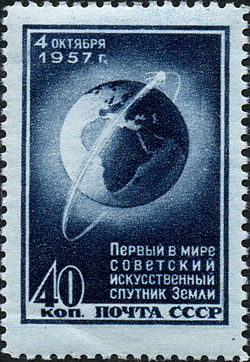This article includes a list of general references, but it lacks sufficient corresponding inline citations .(August 2011) |
| Politics of the Soviet Union |
|---|
 |



Science and technology in the Soviet Union served as an important part of national politics, practices, and identity. From the time of Lenin until the dissolution of the USSR in the early 1990s, both science and technology were intimately linked to the ideology and practical functioning of the Soviet state and were pursued along paths both similar and distinct from models in other countries. Many great scientists who worked in Imperial Russia, such as Konstantin Tsiolkovsky, continued work in the USSR and gave birth to Soviet science.
Contents
- Organization
- Scientific Research Institutes (NII)
- Ideological restrictions on science
- After Soviet collapse
- Soviet Nobel Prize winners in science
- Physics
- Chemistry
- National Prizes
- See also
- References
- External links
The Soviet government made the development and advancement of science a national priority, emphasizing science at all levels of education and showering top scientists with honours. Very large numbers of engineers graduated every year. Soviet scientists won acclaim in several fields, marked by a highly developed pure science and innovation at the theoretical level, though interpretation and application fell short. They were at the cutting edge of science in fields such as mathematics and in several branches of physical science, notably theoretical nuclear physics, chemistry, and astronomy. The physical chemist and physicist Nikolay Semenov was the first Soviet citizen to win a Nobel Prize, in 1956 among several other Soviet Nobel Prize winners and the mathematician Sergei Novikov was the first Soviet citizen to win a Fields Medal in 1970 followed by Grigory Margulis in 1978 and Vladimir Drinfeld in 1990.
Soviet technology was most highly developed in the fields of nuclear physics, where the arms race with the West convinced policy makers to set aside sufficient resources for research. Due to a crash program directed by Igor Kurchatov (based on spies of the Cambridge Five), the Soviet Union was the second nation to develop an atomic bomb, in 1949, four years after the United States. The Soviet Union detonated a hydrogen bomb in 1953, a mere ten months after the United States. Space exploration was also highly developed: in October 1957 the Soviet Union launched the first artificial satellite, Sputnik 1, into orbit; in April 1961 a Soviet cosmonaut, Yuri Gagarin, became the first man in space. The Soviets maintained a strong space program until economic problems led to cutbacks in the 1980s. The Soviet Union also had more scientists and engineers, relative to the world population, than any other major country due to the strong levels of state support for scientific developments by the 1980s. [1]
Although the sciences were less rigorously censored than other fields such as art, there were several examples of suppression of ideas. In the most notorious, agronomist Trofim Lysenko refused to accept the chromosome theory of heredity usually accepted by modern genetics. Claiming his theories corresponded to Marxism, he managed to talk Joseph Stalin in 1948 into banning the practice and teaching of population genetics and several other related fields of biological research; however, this decision was reversed in the 1960s. [2] Cybernetics was also marginalised during the Stalinist period and received a hostile public campaign in 1951. Although, the discipline was rehabilitated during the post-Stalinist period from 1954 until 1959. [3]